Exploring Multnomah Falls: A Natural Wonder
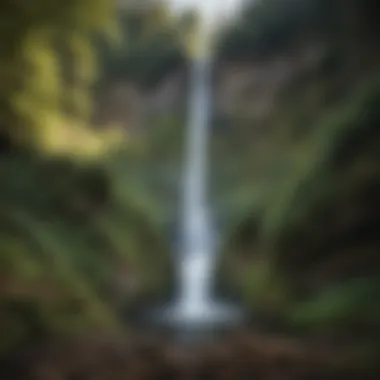
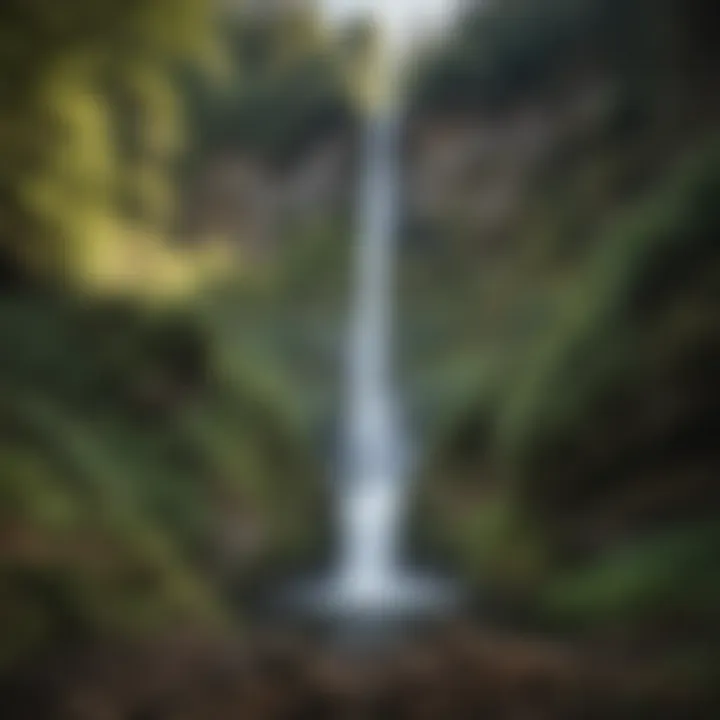
Intro
Multnomah Falls, an impressive cascade located near Portland, Oregon, draws both tourists and locals alike with its breathtaking beauty. The falls, with a height of 620 feet, are the tallest in Oregon, making them a striking feature of the Columbia River Gorge. This article seeks to explore not only the geological magnificence of Multnomah Falls but also its significant ecological contributions and cultural narratives. What makes this site vital extends beyond its aesthetic appeal; it embodies a rich tapestry of woodland ecosystems, sustainability practices, and community stewardship efforts.
The purpose of this exploration is to engage forestry professionals and academics with insightful analysis into the complexities of this natural wonder. Understanding its role in forest ecosystems and conservation strategies is essential for preserving its beauty for future generations.
Understanding Woodland Ecosystems
Importance of Biodiversity in Forests
Biodiversity is crucial for maintaining healthy woodland ecosystems. Multnomah Falls is surrounded by diverse plant and animal species, contributing to the overall ecological balance. Rich biodiversity enhances resilience against diseases and climate variations. The variety of flora includes coniferous trees and understory shrubs, which provide shelter and food for wildlife. The presence of different species helps in pollination, seed dispersal, and soil formation.
- Increased plant diversity contributes to better nutrient cycling.
- A wide range of animal species supports natural pest control.
- Healthy ecosystems are more resilient to environmental changes.
Role of Forests in Climate Regulation
Forests, such as those around Multnomah Falls, play a significant role in regulating the climate. They act as carbon sinks, absorbing carbon dioxide from the atmosphere and mitigating the effects of global warming. Moreover, forests influence local weather patterns, affecting rainfall and temperature. Their ability to stabilize the soil prevents erosion and landslides, especially in areas prone to heavy rain.
To further understand these dynamics, researchers focus on:
- Forest cover: impacts on water cycles.
- Canopy interception: helps reduce runoff.
- Microclimate regulation: maintains biodiversity and habitat stability.
Sustainable Forestry Practices
Principles of Sustainable Forestry
Sustainable forestry aims to maintain and improve the health of forests. This practice emphasizes careful management of resources to balance ecological, economic, and social needs. Forest management plans often include:
- Prioritizing species conservation.
- Implementing controlled logging techniques.
- Investing in reforestation efforts.
Successful sustainable forestry practices bolster local economies while ensuring forest integrity. The careful balance enhances public awareness about the importance of forests.
Case Studies of Successful Implementations
Examining successful case studies can provide valuable insights into effective sustainable forestry practices. For instance, the Gifford Pinchot National Forest in Washington state has implemented various sustainable techniques, which include selective logging and habitat restoration projects. These initiatives have led to healthier ecosystems and improved wildlife populations. Similar examples can be observed at Mount Hood National Forest, where successful reforestation efforts are reported.
Woodland Stewardship Techniques
Forest Management Plans
A well-structured forest management plan is essential for ensuring forests meet environmental, social, and economic needs. Plans often include goals for:
- Enhancing habitat diversity.
- Supporting native species through growth.
- Preventing invasive species from disrupting ecosystems.
These elements are critical for both the ecological integrity of an area and the promotion of sustainable recreation opportunities.
Conservation Strategies
Effective conservation strategies are needed to protect the unique environment of Multnomah Falls. Collaborations between local agencies, conservation organizations, and community members contribute to successful conservation outcomes. Key strategies include:
- Education programs to raise awareness about forest health.
- Volunteer events to foster community involvement.
- Monitoring programs that assess the health of ecosystems over time.
"Conservation is a state of harmony between men and land." – Aldo Leopold
By focusing on these techniques, the message of stewardship can permeate communities, highlighting the interdependence of people and nature.
Understanding the multifaceted significance of Multnomah Falls can inspire further conversations around environmental policy, biodiversity conservation, and sustainable practices in forestry. This natural wonder not only captivates the senses but also serves as a pivotal case study for promoting the ideals of conservation and responsible woodland stewardship.
Understanding Multnomah Falls
Multnomah Falls is not just a picturesque cascade, but a significant natural and cultural landmark that embodies the essence of Oregon's wilderness. Understanding this natural wonder is essential for those who wish to appreciate its geological, ecological, and cultural dimensions. This knowledge helps visitors and locals alike to respect its delicate ecosystems and acknowledges the efforts put forth in conservation and education surrounding the falls.
Geographical Context
Multnomah Falls is located within the Columbia River Gorge, an area renowned for its stunning landscapes and diverse topography. The falls stand at 620 feet, making it the tallest waterfall in Oregon and one of the tallest in the United States. The water flow thunders down two distinct tiers, creating an awe-inspiring sight that draws visitors year-round.
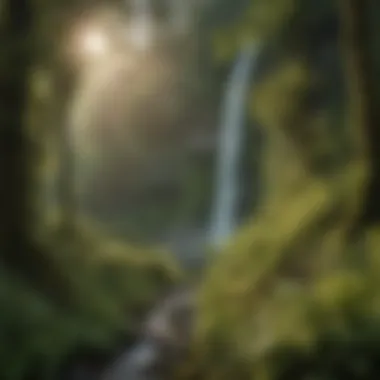

This falls is fed by the snowmelt from the surrounding mountains, predominantly the Cascade Range, and its sources vary in volume depending on the season. For instance, spring offers a robust flow as the snow melts, while summer typically sees a diminishment, revealing the intricate rock formations behind the water.
Visitors can observe a variety of geographical features, such as basalt columns and volcanic formations, which reflect the area's eruptive past. These distinct features enhance the educational value of a visit, thereby serving both to inspire awe and to inform.
Access from Portland
Located merely 30 miles east of Portland, reaching Multnomah Falls is convenient for day-trippers or those seeking a quick retreat into nature. The primary access route is via Interstate 84, which provides a scenic drive along the Columbia River. The trip generally takes about 30 minutes to an hour, depending on traffic and weather conditions.
Upon arrival, visitors will find a well-maintained parking area that offers easy access to the falls. The layout of the site includes paved walkways that lead to vantage points. These paths accommodate various levels of mobility, making the natural wonder accessible to a broad audience.
Moreover, several organized tour options are available for those preferring guided experiences. Tour operators often include stops at other nearby attractions, thus enriching the visit.
Key Points for Access:
- Distance: 30 miles east of Portland
- Drive time: Approximately 30 minutes to 1 hour
- Parking and paved paths available for easy access
Understanding Multnomah Falls encompasses knowing its geographical importance and the ease with which it can be accessed. This knowledge allows for a richer experience and fosters appreciation for the natural beauty that Oregon has to offer.
Geological Formation
Understanding the geological formation of Multnomah Falls is essential for comprehending its current state and significance. The falls are not merely a visual marvel; they are a reminder of the planet's dynamic processes over millions of years. Insight into their formation provides a basis for discussions on ecological balance and conservation strategies, given the unique geological structures supporting diverse ecosystems.
Formation Processes
The formation of Multnomah Falls begins with volcanic activity that originated millions of years ago. The region is part of the Columbia River Basalt Group, formed from extensive lava flows that blanketed the landscape. Eruptions during the Miocene epoch left behind solid rock formations, creating a stage for water to sculpt the terrain. As water from the underground springs flowed over these ancient lava flows, it eroded the softer layers of basalt, carving out the iconic two-tiered waterfall we see today.
This erosion process is continuous, and its pace can vary significantly based on water flow, seasonal changes, and geological shifts. For instance, during periods of heavy rainfall, the increased volume of water enhances erosion, while dry spells may slow the process. Understanding these factors helps in appreciating the fragility of the falls' ecosystem and the ongoing need for protective measures.
Rock Types and Erosion
Multnomah Falls showcases a variety of rock types that contribute to its distinctive appearance. The dominant basalt rock is interspersed with layers of softer sedimentary rock, creating a geological juxtaposition. This contrast plays a critical role in how the falls have developed over time. As water cascades down, it wears away the softer rock more quickly. This differential erosion leads to the development of the plunge pool at the base of the falls, which is continually reshaped by the violent force of the water.
Recent studies suggest that the types of rocks present influence the local hydrology as well. For example, the more porous layers can absorb water during wet periods, which is gradually released, maintaining a consistent flow in drier conditions.
In summary, the geological formation of Multnomah Falls combines ancient volcanic activity with the power of water and time. This understanding is critical for those committed to conservation and maintaining the natural beauty of this landmark. The complex interplay between rock types and erosion patterns allows us to glean insights into not just the history of the falls, but also its future.
Ecological Significance
The ecological significance of Multnomah Falls extends beyond its stunning visual appeal. It serves as an important indicator of the health of the surrounding environment. The falls area offers a unique habitat that supports various species of flora and fauna. Understanding this aspect is essential for conservation, research, and educational purposes.
Biodiversity in the Area
Multnomah Falls lies within a biodiverse region known for its rich plant and animal life. The lush forests surrounding the falls are home to numerous species of trees, including Douglas fir, Western red cedar, and Bigleaf maple. These trees provide essential habitats for various wildlife, while also contributing to the overall ecological balance of the area.
Species such as the barred owl, black-tailed deer, and various migratory birds often utilize this environment for their survival needs. The falls support a network of life that is interconnected, demonstrating how a water source can fuel an entire ecosystem.
"Biodiversity is a key indicator of environmental health, and the rich varieties found around Multnomah Falls highlights its importance in the ecological landscape of the region."
Preserving these species is crucial not just for their survival, but because they play significant roles in maintaining the health of the ecosystem. For instance, pollinators like bees are vital for the reproduction of many plant species, contributing to the overall fertility of the landscape.
Impact on Local Ecosystems
The impact of Multnomah Falls on local ecosystems is profound. The continuous flow of water fosters a microclimate that supports moisture-loving plants and diverse wildlife. This contributes to the overall resilience of the ecosystem, allowing it to recover from disturbances more effectively. For example, the unique hydrology of the area ensures that moisture is available in the drier months, affecting plant growth patterns and wildlife activities.
In addition, healthy water systems like the one created by the falls are crucial for maintaining local fish populations. Salmon and trout utilize these waterways for spawning, indicating the high water quality and ecological integrity of the environment. When these fish thrive, the entire food web benefits.
The relationship between the falls and its surrounding ecosystems is vital for understanding not only the local environment but also broader ecological processes. By studying these interactions, researchers can gain insights into conservation challenges and potential strategies for ecological maintenance.
Cultural Importance
The cultural importance of Multnomah Falls extends beyond its stunning visual appeal. It serves as a critical intersection of history, spirituality, and the natural world. The falls are not only a geophysical marvel but also a landmark deeply ingrained in the narratives of various communities, promoting a sense of belonging and identity.
Historical Perspectives
The history surrounding Multnomah Falls reflects the broader development of the Pacific Northwest. In the late 19th and early 20th centuries, the falls became a focal point for tourism. As the spectacular waterfall garnered increased attention, local entrepreneurs capitalized on its beauty, establishing lodges and attractions that catered to visitors. This shift contributed significantly to the economic development of the area.
Moreover, early settlers and tourists recorded their experiences, which were often romanticized accounts, painting the falls as a symbol of nature's grandeur. Notably, the establishment of the Columbia River Highway in the 1920s paved the way for easier access and further elevated the site's status as a must-visit destination. This infrastructure development led to a symbiotic relationship between the natural site and the local economy, one that continues to thrive today.
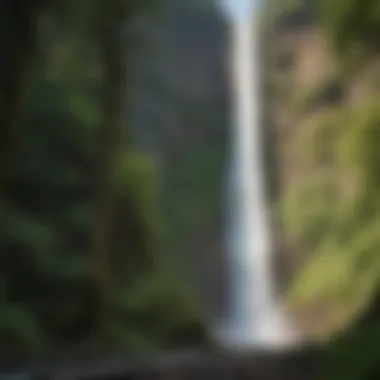
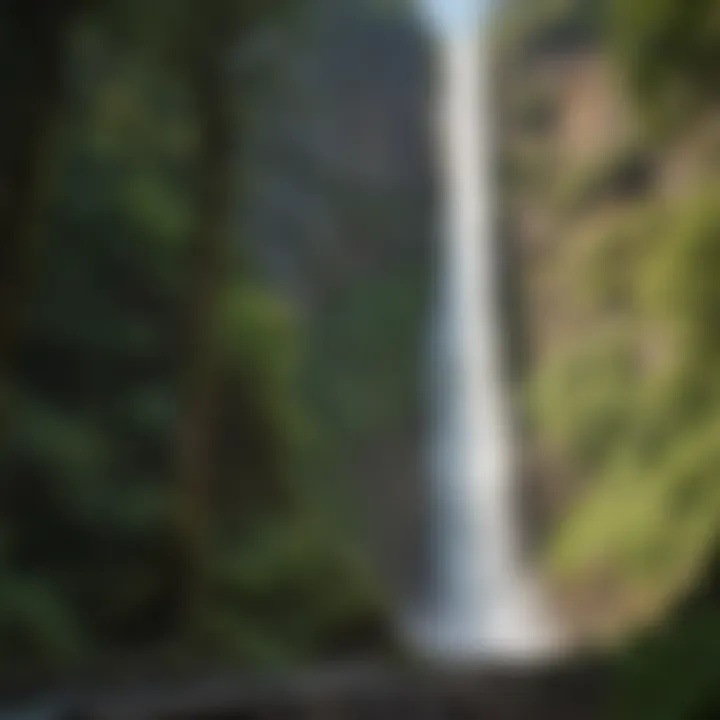
Native American Connections
The historical significance of Multnomah Falls is also deeply intertwined with Native American cultures. The Multnomah tribe, for whom the falls are named, revered this location as sacred. For them, the falls symbolize resilience and the connection between the earth and spirit. Many traditional stories recount the significance of the waters flowing from the falls, often linking them to creation myths and cultural values.
The site has become essential in educating visitors about these native cultures. Various interpretive programs and artifacts share the stories of the tribes that have historically inhabited this region. Understanding this context enriches the visitor experience, offering a dimension that goes beyond mere aesthetics.
"Multnomah Falls is not just a natural wonder; it embodies the spirit and history of the indigenous people connected with this land."
These cultural narratives are essential for fostering a sense of respect and understanding for the indigenous populations and their enduring legacy. Not only do they contribute to the site's cultural mosaic, but they also challenge contemporary visitors to confront their relationship with nature and history. As such, Multnomah Falls stands not only as a picturesque destination but also as a reminder of the cultural histories that inform our understanding of this landscape.
Recreational Opportunities
Recreational opportunities at Multnomah Falls play a vital role in attracting visitors and fostering an appreciation for the natural environment. The falls not only serve as a breathtaking backdrop but also offer various activities that cater to both casual visitors and outdoor enthusiasts. These activities help promote environmental awareness while encouraging people to engage with nature in a meaningful way.
Hiking Trails
The hiking trails surrounding Multnomah Falls provide a wealth of options for individuals interested in exploring the area. The most well-known trail is the Multnomah Falls trail, which leads directly to the viewing platform situated near the base of the falls. This 0.2-mile hike is relatively easy and highly accessible, making it ideal for families and individuals who may not have much hiking experience. However, those seeking a more challenging endeavor can opt for the Angel's Rest Trail or the Larch Mountain Trail. Both trails offer stunning panoramic views of the Columbia River Gorge and the surrounding mountain ranges.
Additionally, each trail showcases the unique flora and fauna of the area. Hikers may encounter both native plants and wildlife, enriching their outdoor experience. It is recommended to wear sturdy footwear and carry water to ensure a safe and enjoyable hike.
Photography and Viewing Areas
Multnomah Falls is a photographer's dream, attracting both amateur and professional photographers alike. The viewing areas present numerous opportunities to capture the falls in different seasons and lighting conditions. The primary viewing point near the lodge offers a direct view of the cascading water, framed by lush greenery and magnificent rock formations.
For those looking to explore more distant viewpoints, several vantage points are scattered along the various trails. Key locations include:
- Upper Viewing Platform: This area provides a higher perspective of the falls, creating an opportunity for dramatic shots that depict the entire cascade.
- Historic Benson Bridge: From this bridge, visitors can capture images from both sides of the falls, allowing for creative compositions that highlight the flow of water.
- Larch Mountain Trail: While more remote, this trail can offer unique viewpoints for sweeping landscape shots that include the falls in context with the surrounding region.
"The best time to photograph the falls is during early morning or late afternoon when the light casts softer shadows and enhances the colors of the landscape."
Understanding these recreational opportunities is essential as they highlight the significance of Multnomah Falls beyond just its sheer beauty. They encourage the exploration and preservation of natural ecosystems, making it a destination that appeals to a wide demographic while promoting a strong commitment to conservation.
Conservation Efforts
Multnomah Falls, as one of Oregon's most iconic natural features, undergoes various conservation efforts to protect its delicate ecosystem. The focus on conservation is critical, considering the numerous pressures from tourism, invasive species, and climate change. These conservation strategies ensure that the natural beauty and ecological integrity of the falls are preserved for future generations.
Protection of Natural Resources
Protecting the natural resources at Multnomah Falls is paramount. Water quality is essential for both the health of the falls and the surrounding ecosystems. To safeguard this resource, ongoing monitoring systematically checks for pollutants and sediment levels. Additionally, efforts to restore native flora help stabilize the soil and promote biodiversity, which can further enhance water quality.
Efforts also include the maintenance of wildlife habitats. The region is home to various species, such as deer, birds, and fish. Protecting their habitats ensures a balanced ecosystem where each species can thrive. The Oregon Department of Fish and Wildlife, in collaboration with local organizations, participates in habitat restoration projects to improve the living conditions for these animals.
Moreover, regulations are put in place to manage human interaction with the environment. Visitors are encouraged to remain on marked trails to minimize trampling of sensitive vegetation. When done consciously, these actions contribute significantly to the preservation of natural resources.
Community Involvement
Community involvement plays a crucial role in the conservation of Multnomah Falls. Local residents, organizations, and volunteers participate in various initiatives aimed at enhancing conservation efforts. One notable example includes cleanup events organized by local environmental groups. These activities not only help maintain the visual beauty of the area but also educate the public about the importance of proper waste management.
Furthermore, several local education programs raise awareness regarding conservation. Schools and educational institutions partner with conservation organizations to teach students about local ecosystems. Community workshops on sustainable practices also empower residents to contribute actively to their environment’s well-being.
Local businesses also play a part, often sponsoring conservation initiatives. By investing in local efforts, they help foster a sense of stewardship among the community. Their contributions can target specific goals, such as supporting wildlife monitoring or funding educational programs.
Investing in community involvement not only benefits Multnomah Falls but also fosters a culture of conservation that can extend beyond the immediate area.
Multnomah Falls and Climate Change
The increasing discourse on climate change accentuates its impact on natural landmarks like Multnomah Falls. This iconic site not only showcases stunning scenery but also serves as a barometer for environmental changes. Assessing the effects of climate change on the falls offers insights into the broader implications for biodiversity, water resources, and ecosystem integrity.
Effects on Water Flow
The water flow at Multnomah Falls is primarily driven by mountain snowmelt and rainfall, both of which are sensitive to changes in climate. As temperatures rise, the snowpack in the region becomes less stable, causing earlier snowmelt. This shift can lead to reduced water flow in summer months when it is most needed to sustain temperate ecosystems. In addition, erratic weather patterns, such as increased instances of drought or intense rain, disrupt the typical hydrological cycles.
There are several important considerations regarding these changes:
- Reduced Seasonal Flow: An early melt restricts the availability of water during the summer, impacting flora and fauna that depend on consistent water supply.
- Erosion and Sedimentation: Increased flow variability can exacerbate erosion, affecting the stability of the surrounding terrain and watercourse.
- Temperature Effects: Warmer water temperatures can harm aquatic life, decreasing oxygen levels and negatively influencing species diversity.
"The changes in water flow not only affect the falls but also ripple through the entire ecosystem, highlighting the interconnectedness of these natural systems."
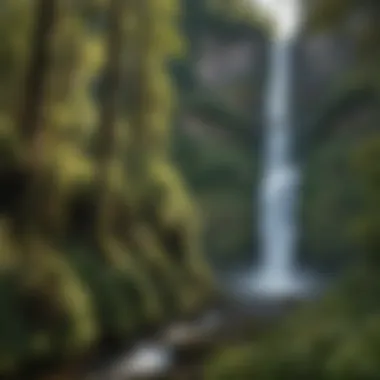
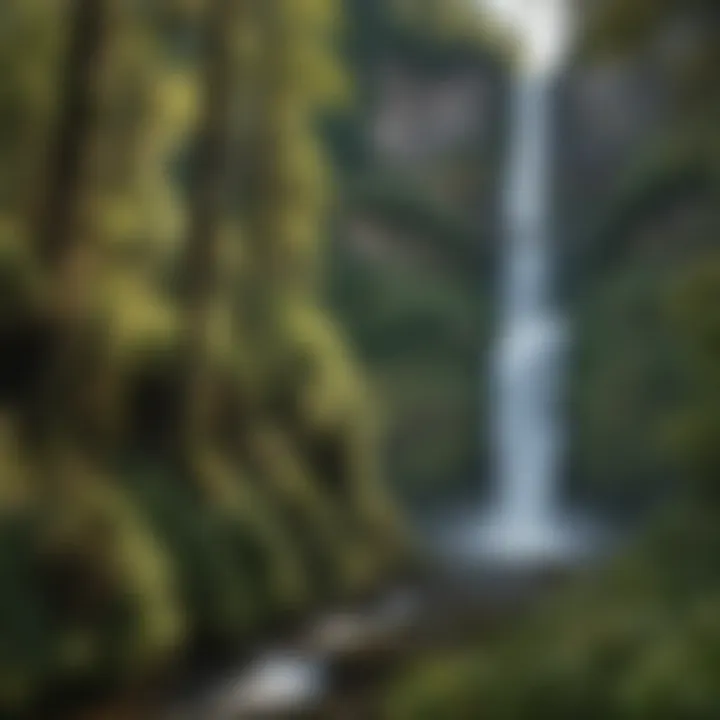
Adaptive Management Strategies
In response to the pressing challenges posed by climate change, several adaptive management strategies can be employed. These strategies aim to enhance resilience and reduce vulnerabilities of Multnomah Falls. Some effective approaches include:
- Watershed Management: Protecting and restoring the watershed can help maintain water quality and availability. This involves managing land use practices and engaging with local stakeholders.
- Monitoring Programs: Implementing rigorous monitoring of climactic and hydrological changes provides valuable data that can inform long-term decision making.
- Ecological Restoration: Reestablishing native vegetation along riverbanks helps stabilize soil and enhance biodiversity, creating a buffer against the impacts of climate change.
- Public Awareness Campaigns: Educating visitors and local communities about the effects of climate change can foster a sense of stewardship. Community involvement is vital for successful conservation efforts.
Visitor Experience
Understanding the visitor experience at Multnomah Falls is critical for several reasons. This natural landmark attracts a diverse array of visitors, ranging from casual tourists to serious nature enthusiasts. A well-structured visitor experience enhances appreciation for the geological and ecological values inherent in the site. As such, comprehending the facilities and amenities available, along with the opportunities for guided tours, is essential. It allows individuals to maximize their enjoyment while fostering a deeper connection to the environment.
Facilities and Amenities
The facilities and amenities at Multnomah Falls are thoughtfully designed to accommodate various visitor needs. The entrance area features restrooms, a gift shop, and snack stands. These conveniences ensure that guests can enjoy their visit without unnecessary discomfort. There is ample parking available, with dedicated spots for larger vehicles and those with accessibility requirements.
Visitors have access to picnic areas, which are perfect for family gatherings or a quiet lunch amidst nature. Moreover, the paved paths leading to the falls are well-maintained, allowing for easier navigation, especially for families or elderly visitors. Additionally, information signage throughout the area helps educate visitors about the falls' significance parallel to their leisure experience.
Guided Tours
Guided tours offer a unique layer to the visitor experience at Multnomah Falls. These tours are led by knowledgeable guides who provide insights that go beyond the superficial beauty of the falls. They delve into the geological formations, local flora, and fauna, and the cultural histories interwoven with the landscape.
Some guided tours include:
- Nature Walks: Focusing on local biodiversities, these walks allow visitors to experience the ecosystem in a hands-on manner.
- Photography Tours: Specialized for photography enthusiasts, these tours are designed to capture the falls under ideal conditions, emphasizing lighting and perspectives.
- History Tours: These are centered on the cultural significance of the area, providing historical context and stories of the early settlers and Native American connections.
Participating in a guided tour enriches the overall experience, allowing visitors to foster a stronger connection to Multnomah Falls.
"The well-rounded visitor experience at Multnomah Falls is not just about the stunning views, but also about the deeper understanding of its natural and cultural significance."
Exploring the Surrounding Area
Understanding the area around Multnomah Falls enriches the overall experience for visitors. The surrounding landscape is not just beautiful but also important in various ecological and cultural contexts. It offers insight into the natural processes at work and the human narratives that have unfolded in this setting.
Columbia River Gorge Overview
The Columbia River Gorge is a significant geographical feature that suggests both majesty and complexity. Stretching for over eighty miles, this canyon varies in elevation and ecology. It serves as a major pathway for wildlife and plant species, making it a vital region for biodiversity. The clash of different climates, from the moist air coming from the Pacific Ocean to the dry conditions of eastern Oregon, creates diverse ecosystems within a relatively small area.
Visitors to the Gorge will find numerous outdoor activities available. Hiking is particularly popular, with trails that lead to stunning overlooks and hidden waterfalls beyond Multnomah Falls. Locations like Crown Point offer panoramic views of the Gorge, showcasing the stunning layers of rock formations that characterize the area. Additionally, the Columbia River is a hub for water sports, including kayaking and paddle boarding, providing unique perspectives of the landscape.
Nearby Attractions
The vicinity of Multnomah Falls is replete with attractions that cater to diverse interests. Here are some notable spots:
- Latourell Falls: A nearby waterfall offering a somewhat less crowded alternative for those who wish to enjoy nature without the busyness of Multnomah Falls.
- Beacon Rock: A natural monument rising over the river, providing a challenging hike and extraordinary views from the summit.
- Historic Highway: This scenic route connects various attractions and historical sites, revealing stories of the region's past.
- Bonneville Dam: Located a bit further east, it illustrates the role of human engineering in natural resource management.
Visiting these sites adds depth to the experience of exploring the area, allowing for a comprehensive understanding of both natural history and the human connection to the environment. The combination of natural wonders and cultural landmarks creates a rich tapestry that resonates with each visitor.
Exploring the surrounding attractions enhances the appreciation of Multnomah Falls itself, encouraging a broader understanding of the natural and cultural landscapes that define this remarkable region.
Ending
The conclusion of this article encapsulates the multifaceted significance of Multnomah Falls and its position in the broader context of environmental conservation, cultural heritage, and ecological dynamics. The examination of the falls not only highlights its stunning geological features but also elucidates its role as a crucial habitat supporting a wide array of biodiversity.
Understanding these elements is vital for forestry professionals and academics alike. The insights gathered from the various sections of the article provide a comprehensive view of how geological formations shape ecosystems and influence local flora and fauna. This knowledge fosters a deeper appreciation for the delicate balance of nature and encourages thoughtful stewardship.
Reflecting on Multnomah Falls
Multnomah Falls serves as a powerful symbol of natural beauty and resilience. Visitors are often in awe of the cascading waters and the lush surrounding flora, which stand as a testament to the ecological diversity of the Columbia River Gorge. Reflecting on the falls means recognizing the intricate interplay between geological processes and the living organisms that thrive in this unique environment. It prompts individuals to consider how such natural wonders can enrich human experience while also demanding our respect and protection.
Call to Action for Conservation
In light of the changing environmental conditions, a call to action for conservation is essential. The increasing disturbances due to climate change and human actions threaten not just Multnomah Falls but the overall health of the ecosystems within the gorge. Professionals in forestry and conservation must advocate for sustainable practices that support both preservation and responsible tourism.
Key considerations include:
- Supporting local conservation organizations that work to protect natural resources.
- Implementing sustainable tourism practices to minimize environmental impact.
- Educating the public on the ecological significance of the area and the importance of conservation efforts.
The beauty and importance of Multnomah Falls extend beyond its picturesque view; it represents an urgent need for collective action to ensure that this natural marvel remains a thriving sanctuary for generations to come.
"The preservation of the natural world is an enduring commitment that benefits both nature and humanity."
To learn more about conservation efforts and participate, consider following relevant resources on platforms like Wikipedia, Britannica, or local community forums on Reddit.
Through concerted efforts and dedication, we can secure the future of Multnomah Falls and its surrounding ecosystems.





